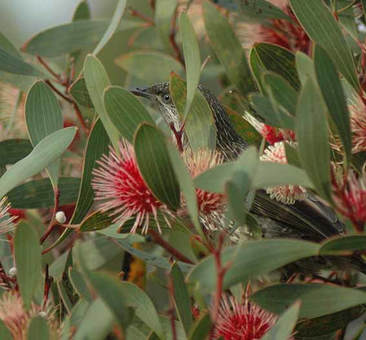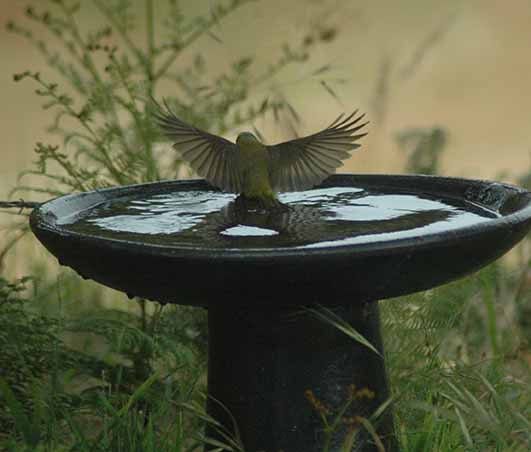 Honeyeater in hakea.
Honeyeater in hakea. Photos: Catherine Watson
By Anne Heath Mennell
THOSE of us in Bass Coast lucky enough to have a garden are probably full of plans for planting, tending and developing our plots before the onslaught of summer. Research is demonstrating the many ways that gardens and gardening can improve our physical and psychological health. In National Gardening Week, spare a thought for those who have no gardens at all, or only a tiny courtyard or balcony, and who miss out on the benefits.
You don’t need to give over the whole of your garden to wildlife as long as you have a space which can be protected from dogs, cats, foxes and similar predators. You can still plant non-indigenous and exotic plants but a variety of native species will be necessary to support some animals and insects.
A first step is to provide a few permanent, safe water sources which are not on the ground. If some of them are shallow, they will protect insects like bees from drowning. If you are worried about mosquitos, remember insects of all kinds have a role to play in a healthy system, even mozzies. They will be food for some birds, lizards and other predatory insects such as spiders.
As well as water, all living things need food and shelter. Some species have flexible requirements but others have very specific needs, which is where we can help. A diversity of plants providing seeds, nectar (sugar) and pollen (protein) will support birds and useful pollinators. Some native plants have developed to attract or deter certain insects. Conversely, some birds and insects are attracted by certain colours or have developed beaks or mouths which match with certain flower shapes. Cultivars, hybrids and exotic species may lack the flower shapes, colour frequencies and nectar, pollen or scent cues which attract those pollinators. Food sources are needed all year round so think about flowering and fruiting times when preparing new plantings.
Shelter requirements are as varied as the critters you want to attract. If you have mature trees in your garden, especially if they have hollows, then celebrate them! Even dead trees can provide homes and food for insects, mosses and fungi. They can also provide perches for hunting birds like kookaburras which need to have some height in order to spot prey on the ground. A paddock without trees is a green desert for these birds. In my garden I have a palm, planted by a previous owner. I’m not a great fan of palms but, at this time of year, I often see a bird, upside down on the fibrous trunk, picking away at the fibres to carry away and build a new home. It can take ages to prise one from its hold and I watch in awe, admiring their tenacity.
If you lack trees and have the room, plant some, especially varieties which will form hollows eventually. In the meantime, put up a variety of boxes to suit a variety of potential occupants including birds, mammals, reptiles and bats and perhaps build an ‘insect hotel’ which will provide homes for a variety of insects. Plant in layers, both horizontal and vertical, using dense, clumping and thorny plants to provide varying levels of shade and protection for smaller birds. Add in some sunny spots on rocks, crevices and mulch (for basking amphibians), logs and dead wood (for insects and bacteria), clay and muddy areas for burrowing in (frogs and certain bees) and dusty areas for birds to bathe in. Dust baths are vital for healthy feathers and a lack can affect birds’ flight abilities.
There are benefits for us gardeners in this process. Do you, like me, have spider webs around your windows and under the veranda or carport roofs? If you do, stop worrying about them or making plans to spring clean. Apart from their primary use of catching insects, many native species use webs in nest-building so leave them be, at least through spring.
We gardeners can also get away with less maintenance in the form of spraying (avoid), pruning (leave as long as possible), mowing ( many species are seed eaters), weeding (some butterflies will use stinging nettles as larval food sources and the local Meadow Argos will use capeweed) and tidying (leaf litter can be home to many insects and invertebrates).
In return, we can enjoy seeing and hearing a multitude of visitors and helpers in terms of eating harmful insects, moulds and bacteria and pollinating our useful and edible plants. They will help to keep a healthy balance in your garden and to keep intact the vital connections in the web of life we humans are still learning about. As the saying goes, “Build it and they will come”.
